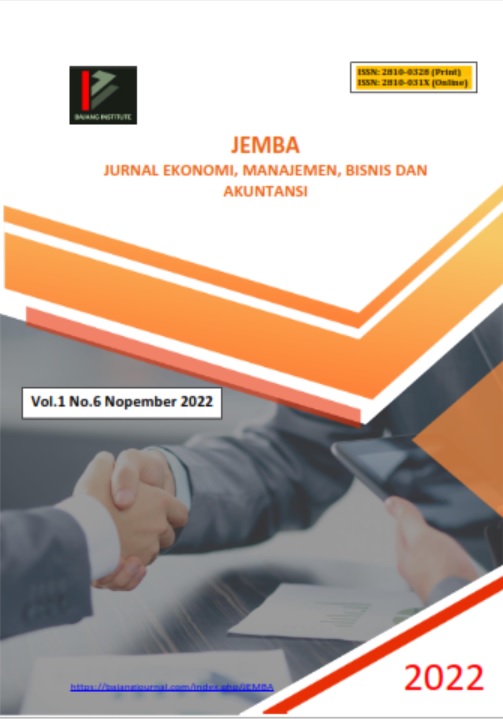PERAN PEMBERDAYAAN KARYAWAN PADA INTENTION TO QUIT: KINERJA SEBAGAI VARIABEL MEDIASI
DOI:
https://doi.org/10.53625/jemba.v1i6.3904Keywords:
Empowerment, Intention To Quit, PerformanceAbstract
Objectives–This study aims to examine and analyze the role of employee empowerment on the intention to quit with performance as a mediating variable. Design/Methodology/Approach – This research uses quantitative methods and uses a population of 76 employees of Arya Mandiri Teknik Yogyakarta staff. Questionnaire method. Instrument test and classical assumption test. SEM-PLS program data analysis tool. Research Results–Employee empowerment has a positive and significant role in performance and Intention to Quit. Meanwhile, performance plays a positive and significant role in the Intention to Quit, and performance mediates the role of employee empowerment in the intention to quit. Originality – Research using established variables needs to be done as a reinforcement of existing theories, as well as contributing to the development of other, more specific variables
References
Ahmad, I., & Manzoor, S. R. (2017). Effect of teamwork, employee empowerment and training on employee performance, 7(11). International Journal of Academic Research in Business and Social Sciences, 380-394.
Ahmad, N., Iqbal, N., Javed, K., & Hamad, N. (2014). Impact of organizational commitment and employee performance on the employee satisfaction, 1(1). International Journal of Learning, Teaching and Educational Research, 84-92.
Arep, I., & Hendri, T. (2003). Manajemen Sumber Daya Manusia. Jakarta: Universitas Trisakti.
Arikunto, S. (2016). Prosedur Penelitian: Suatu Pendekatan Praktik. Jakarta: Rineka Cipta.
Berry, M. W., & Kogan, J. (2010). Text Mining Aplication and theory. United Kingdom: WILEY.
Brown, M., Kraimer, M. L., & Bratton, V. K. (2019). The influence of employee performance appraisal cynicism on intent to quit and sportsmanship. Personnel Review.
Daft. (2010). Era Baru Manajemen. Jilid 1. Edisi ke Sembilan. Jakarta: Salemba Empat.
Elseidi, R. I., & EL-bAZ, D. (2016). Electronic word of mouth effects on consumers’ brand attitudes, brand image and purchase intention: an empirical study in Egypt. The Business and Management Review.
Ghozali, I. (2018). Aplikasi Analisis Multivariate dengan Program IBM SPSS 25. Semarang: Badan Penerbit Universitas Diponegoro:.
Glissmeyer, M., Bishop, J. W., & Fass, R. D. (2007). Role Conflict, Role Ambiguity, and Intention To Quit The Organization: The Case of Law Enforcement Officers. Journal of Decision Sciences Institute Annual, 158-469.
Husaini, U. (2009). Metodologi Penelitiam Sosial. Jakarta: Bumi Aksara.
Inuwa, M. (2016). Job satisfaction and employee performance: An empirical approach, 1(1). The Millennium University Journal, 90-103.
Kumar, D., Singh, R. M., & Rangnekar, S. (2018). The effects of psychological empowerment on intention to quit job: the mediating role of job satisfaction among Airforce personnel, 10(2). Asian Journal of Information and Communications, 19-31.
Lacap, J. P. (2019). The mediating effect of employee engagement on the relationship of transformational leadership and intention to quit: Evidence from local colleges in Pampanga, Philippines. 19(1). Asia-Pacific Social Science Review, 33-48.
Mahmudi. (2007). Manajemen Kinerja Sektor publik. Yogyakarta: UPP STIM YKPN.
Nitisemito, A. S. (2000). Manajemen Personalia: Manajemen Sumber Daya Manusia, Ed. 3. Jakarta: Ghalia Indonesia.
Queiri, A., & Dwaikat, N. (2016). Factors affecting Generation Y employees’ intention to quit in Malaysian’s business process outsourcing sector, 9(2). Journal of Sustainable Development, 78.
Robbins, S. P., & Coulter, M. (2016). Manajemen. Edisi 13. Jakarta: Erlangga.
Sarwoto. (2015). Dasar-Dasar Organisasi Manajemen. Jakarta: Ghalia.
Schein, E. H. (2004). Organizational Culture and Leadership. San Francisco: Third Edition, Jossey –Bass Publishers,.
Sedarmayanti. (2003). Sumber Daya Manusia dan Produktivitas Kerja. Bandung: Penerbit Mandar Maju.
Thurston, E., & Glendon, A. I. (2018). Association of risk exposure, organizational identification, and empowerment, with safety participation, intention to quit, and absenteeism. Safety Science, 212-221.












